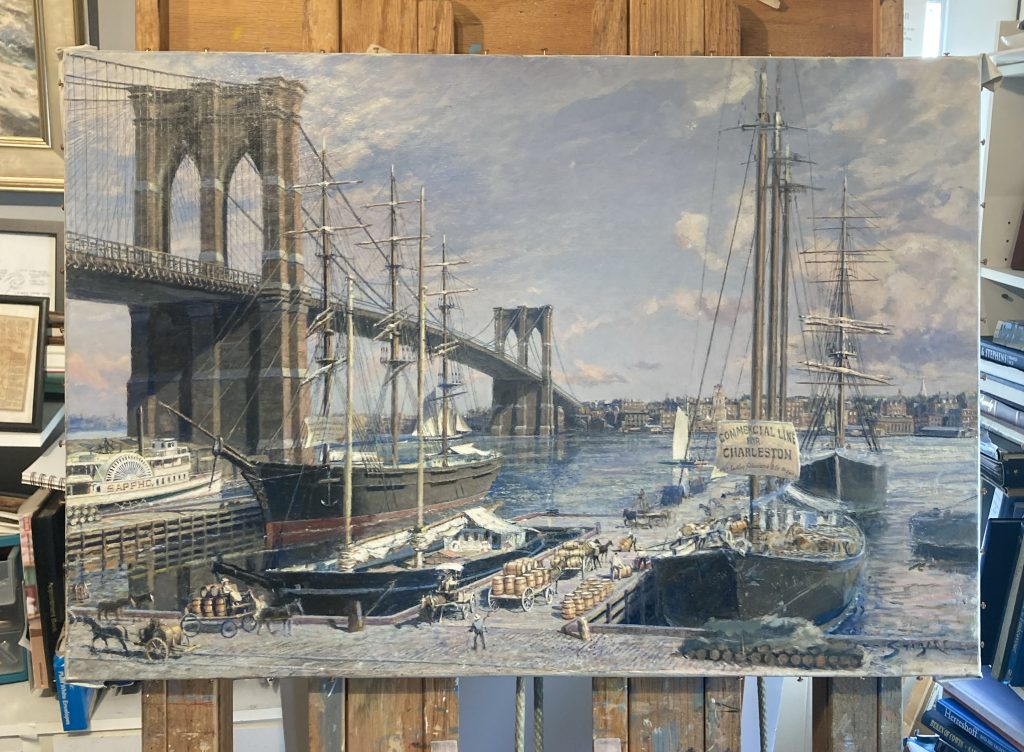The painting (above) as it was last touched by John, now on my easel here in Mystic.
Finishing a John Stobart Painting
I am deeply honored to have been asked by John Stobart’s widow (and head of the Stobart Foundation) to finish a painting of South Street (at his request) he was unable to complete before his passing early this year. I will be regularly chronicling my progress finishing the piece using John’s notes, research, methods and materials in a series of blog posts, below:
Chapter 1: An Introduction (previous post)
Chapter 2: John’s Methods & Materials (previous post)
Chapter 3: The Subject Matter Depicted (previous post)
Chapter 4: What Needs to Be Done (previous post)
Chapter 5: Starting the Painting Process (previous post):
Chapter 6: Finishing the Downeaster (previous post):
Chapter 7: Finishing the Black Schooner (previous post):
Chapter 8: My Other All Time Hero (previous post)
Chapter 9: From Blob to Barge (below)
Chapter 10: Nearly Finished, And Discovering An Earlier Version Of The Painting (next post)
Chapter 11: Finally Finished (next post)
Getting to the most complex and crucial part of the painting, the foreground-most schooner, with all the activity aboard, and the other vessels on the far right hand of the composition. This is also where I had to do the most guesswork about what John may have been thinking when he roughly blocked in the shapes. In fact, the vessel that runs off the right margin was nothing more than a smudge, several very quick brushstrokes which were just an indistinct, gray placeholder for whatever was to come later from his fertile imagination. I took to calling it ‘The Blob’.
Looking back over John’s reference book, Maritime New York in 19th Century Photographs, in which I found several of the other vessels and dock activity he likely used while conceptualizing the painting, I noticed many pictures of canal barges, which were a fixture along South Street back in the 1880s. These may have traversed the Erie Canal or been used for general cargo handling between Hudson and East River destinations. Knowing John’s keen interest in representing many diverse types of maritime traffic in his scenes, it made sense to me that ‘The Blob’ may have eventually become one of these canal barges tied up on the next dock to the south. In fact ‘The Blob’ looked to me to be the general shape of a barge from our perspective, and so I decided that’s what it would become. Here’s the picture of the barges from the book (below); note it is laundry day, another detail of life on the docks that John would have delighted in including. For reference, here too is one of his Mississippi River paintings, also on laundry day!
In addition, I finished the Downeaster at the far end of the dock, behind the unfinished foreground boat, and begun to add some underpainting of sunlight illuminating the foreground boat’s hull — assuming John himself, who loved to paint light and its effects, would have chosen this sunlit area to make the painting’s boldest statement. In a previous chapter I wrote about John’s use of light for emphasis in his works, which I described as pure Stobart magic. I can only assume he would have done this here as well, or at least would approve. Much is left to do here with rigging, anchors, lines, etc etc., but I have finished all the barrels (!) loaded on board and attendant figures.
Here’s the painting before the work described above was done, and after:


Throughout this project I’ve been rewatching his PBS series “John Stobart’s Worldscapes” which are now thankfully all on Youtube. What a masterclass they are, not only for painting but seeing the world through an artist’s eyes and many insightful lessons on his journey and those of his fellow painters. They are a tremendous resource, insights for me into his techniques and methods, and a way to keep my friend present in my studio as I work on this terrific challenge. He was a big believer in the value of painting outdoors to inform his large studio works and a natural teacher, eager to share his knowledge and enthusiasm, and encourage young artists to develop and achieve. Here’s a wonderful clip where John talks about how he created his large studio paintings:
Next: Chapter 10: Discovering an earlier version of the painting



